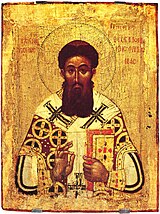| Part of a series on |
| Palamism |
|---|
 |
|
|
| Part of a series on the |
| Eastern Orthodox Church |
|---|
| Overview |

Palamism or the Palamite theology comprises the teachings of Gregory Palamas (c. 1296 – 1359), whose writings defended the Eastern Orthodox practice of Hesychasm against the attack of Barlaam. Followers of Palamas are sometimes referred to as Palamites.
Seeking to defend the assertion that humans can become like God through deification without compromising God's transcendence, Palamas distinguished between God's inaccessible essence and the energies through which he becomes known and enables others to share his divine life.[1] The central idea of the Palamite theology is a distinction between the divine essence and the divine energies[2] that is not a merely conceptual distinction.[3]
Palamism is a central element of Eastern Orthodox theology, being made into dogma in the Eastern Orthodox Church by the Hesychast councils.[4] Palamism has been described as representing "the deepest assimilation of the monastic and dogmatic traditions, combined with a repudiation of the philosophical notion of the exterior wisdom".[5]
Historically, Western Christianity has tended to reject Palamism, especially the essence–energies distinction, sometimes characterizing it as a heretical introduction of an unacceptable division in the Trinity.[6][7] Further, the practices used by the later hesychasts to achieve theosis were characterized as "magic" by the Western Christians.[4] More recently, some Roman Catholic thinkers have taken a positive view of Palamas's teachings, including the essence–energies distinction, arguing that it does not represent an insurmountable theological division between Roman Catholicism and Eastern Orthodoxy.[8]
The rejection of Palamism by the West and by those in the East who favoured union with the West (the "Latinophrones"), actually contributed to its acceptance in the East, according to Martin Jugie, who adds: "Very soon Latinism and Antipalamism, in the minds of many, would come to be seen as one and the same thing".[9]
- ^ Gerald O'Collins, Edward G. Farrugia. A Concise Dictionary of Theology (Paulist Press 2000) p. 186/260.
- ^ Fred Sanders, The Image of the Immanent Trinity (Peter Lang 2005), p. 33.
- ^ Nichols, Aidan (1995). Light from the East: Authors and Themes in Orthodox Theology. Part 4. Sheed and Ward. p. 50. ISBN 978-0-7220-5081-1.
- ^ a b Fortescue, Adrian (1910), Hesychasm, vol. VII, New York: Robert Appleton Company, retrieved 2008-02-03
- ^ Hastings, Adrian; Mason, Alistair; Pyper, Hugh S. (2000). The Oxford companion to Christian thought. Oxford University Press US. p. 88. ISBN 978-0-19-860024-4.
[T]he ending of iconoclasm coincided with a renewal of the monastic life, heralded by the Studite reform of Theodore in the interlude between the first and second periods of iconoclasm. […] The renewal of monasticism led to a deepening sense of the importance of the inner wisdom represented by the monks. A pivotal figure in this, controversial in his time, was Symeon the New Theologian.
- ^ Cite error: The named reference
Meyendorffwas invoked but never defined (see the help page). - ^ "No doubt the leaders of the party held aloof from these vulgar practices of the more ignorant monks, but on the other hand they scattered broadcast perilous theological theories. Palamas taught that by asceticism one could attain a corporal, i.e. a sense view, or perception, of the Divinity. He also held that in God there was a real distinction between the Divine Essence and Its attributes, and he identified grace as one of the Divine propria making it something uncreated and infinite. These monstrous errors were denounced by the Calabrian Barlaam, by Nicephorus Gregoras, and by Acthyndinus. The conflict began in 1338 and ended only in 1368, with the solemn canonization of Palamas and the official recognition of his heresies. He was declared the 'holy doctor' and 'one of the greatest among the Fathers of the Church', and his writings were proclaimed 'the infallible guide of the Christian Faith'. Thirty years of incessant controversy and discordant councils ended with a resurrection of polytheism" Simon Vailhé (1909). "Greek Church". Catholic Encyclopedia, New York: Robert Appleton Company.
- ^ Michael J. Christensen, Jeffery A. Wittung (editors), Partakers of the Divine Nature (Associated University Presses 2007 ISBN 0-8386-4111-3), pp. 243–244
- ^ "Martin Jugie, The Palamite Controversy". 13 June 2009. Retrieved 2010-12-27.
© MMXXIII Rich X Search. We shall prevail. All rights reserved. Rich X Search
